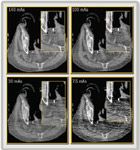Article
Imaging ureteral stones with ultra low-dose CT protocol reduces exposure by 95%
Ultra low-dose CT imaging (7.5 mA seconds) offers equivalent sensitivity and specificity for detecting ureteral stones compared with a standard CT scanning protocol (140 mA seconds) while reducing radiation exposure by 95%.
Loma Linda, CA-Ultra low-dose CT imaging (7.5 mA seconds) offers equivalent sensitivity and specificity for detecting ureteral stones compared with a standard CT scanning protocol (140 mA seconds) while reducing radiation exposure by 95%, according to research conducted at Loma Linda University Medical Center, Loma Linda, CA.
Researchers reported outcomes of their prospective study investigating distal ureteral stone detection in a cadaveric model using six different CT dosing protocols (J Urol 2009; 182:2762-7). Between zero and three calcium oxalate stones measuring 3-, 5-, or 7-mm in length were placed in 56 random configurations into the distal ureters of seven human cadaveric urinary tracts. The urinary tracts were then put into a female human cadaveric vehicle for CT scanning, and the images were read independently by two blinded radiologists, one an attending board-certified abdominal imaging specialist and the other a senior radiology resident.

"Since urinary calculi are dense, they image well, and as our study shows, distal ureteral stones can be readily detected by readers with varying levels of expertise when the CT scan is performed using an ultra low dose of radiation."
Reviewing some statistics to put the issue of radiation exposure from CT scans into perspective, Dr. Baldwin noted that the radiation exposure from an abdominal CT is equivalent to that of 500 chest x-rays, and a CT of the abdomen and pelvis is equivalent to 1,000 chest x-rays. In addition, it is estimated that one in 1,000 patients may die of a fatal cancer because of the radiation exposure associated with a single noncontrast abdominopelvic CT scan.
"The radiation exposure from a 7.5 mA seconds abdominopelvic CT scan is similar to that of a single KUB," said Dr. Baldwin.
Advantages over prior studies
Previous studies have investigated the feasibility of low-dose CT scans for urinary calculi detection using isolated porcine kidneys, software modifications of conventional CT images to simulate noise associated with use of a lower setting, or by repeat scanning of actual patients. However, the model used by the Loma Linda researchers overcomes some of the limitations of these earlier studies as it simulates a challenging clinical scenario while providing a true denominator that allows accurate determination of the sensitivity and specificity of the various scanning protocols.
"In our study, all stones were placed in the distal ureters of cadaveric sources with no history of stone disease and using a technique that avoided inducing hydronephrosis," said first author Forrest Jellison, MD, a urology resident at Loma Linda. "In addition, the cadaveric vehicle into which the urinary tracts were placed was overweight (BMI 26 kg/m2), had multiple calcifications in the abdominal vessels, and was imaged with the arms positioned alongside the body. This created a very difficult interpretation scenario for the radiologists.
"Importantly, we also had a known reference standard with respect to stone size, site, and composition."
The ultra low-dose CT protocol is currently used at Loma Linda for diagnostic evaluation of pediatric patients, patients with a BMI <30 kg/m2 who underwent a conventional CT within the past few years and present with pain suggestive of stone disease, and for post-treatment assessment of residual stones, although investigators are exploring additional uses.
"Currently, we and other groups are investigating how well the ultra low-dose protocols perform for stone detection in obese patients and for diagnosing nonurologic pathologies that may be identified by conventional CT scanning in patients with an acute presentation of flank pain," Dr. Baldwin said.
Newsletter
Stay current with the latest urology news and practice-changing insights — sign up now for the essential updates every urologist needs.















